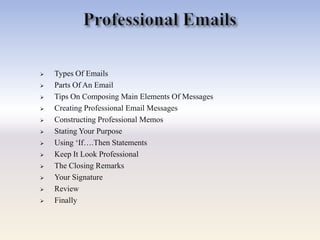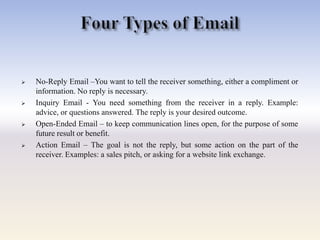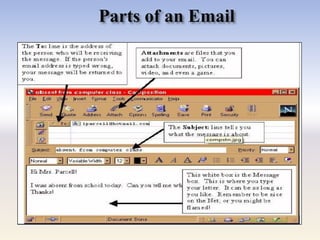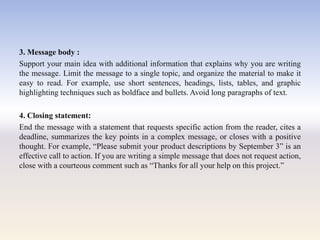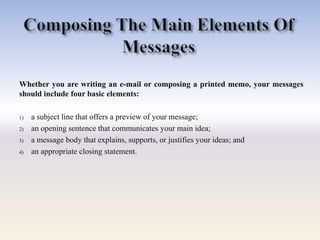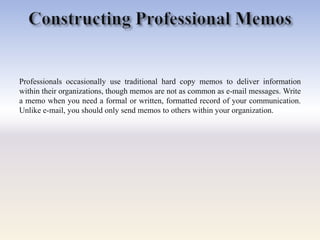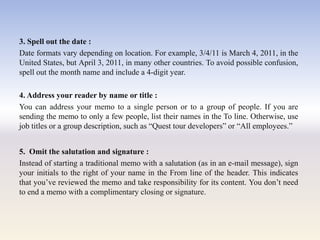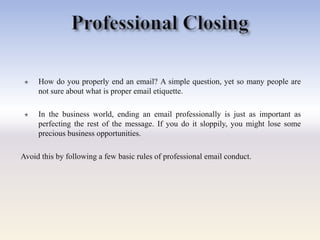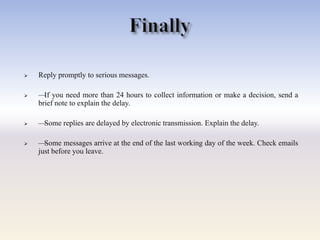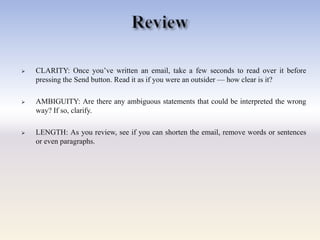Professional e mail presentation
- 1. Types Of Emails Parts Of An Email Tips On Composing Main Elements Of Messages Creating Professional Email Messages Constructing Professional Memos Stating Your Purpose Using ‗If….Then Statements Keep It Look Professional The Closing Remarks Your Signature Review Finally
- 2. No-Reply Email –You want to tell the receiver something, either a compliment or information. No reply is necessary. Inquiry Email - You need something from the receiver in a reply. Example: advice, or questions answered. The reply is your desired outcome. Open-Ended Email – to keep communication lines open, for the purpose of some future result or benefit. Action Email – The goal is not the reply, but some action on the part of the receiver. Examples: a sales pitch, or asking for a website link exchange.
- 3. Parts of an Email
- 4. 1. Subject line : Use a concise phrase that summarizes the main idea of your message. Busy people often decide whether to open an e-mail message based on the subject line. For example, ―Meeting on Tuesday at 10:00‖ and ―Report on fall trade show‖ are effective subject lines, while ―Important,‖ ―Problems,‖ and ―Meeting‖ are not. Table A-2 lists the do‘s and don‘ts for including subjects and other basic e-mail element. 2. Opening sentence : Communicate the main idea of your message in the first sentence. You can do this by restating and expanding the subject line, as in ―Let me know if you can attend the project meeting scheduled for Tuesday, April 4, at 10:00 A.M.‖ If you are delivering bad news, however, you should start with a softer approach.
- 5. 3. Message body : Support your main idea with additional information that explains why you are writing the message. Limit the message to a single topic, and organize the material to make it easy to read. For example, use short sentences, headings, lists, tables, and graphic highlighting techniques such as boldface and bullets. Avoid long paragraphs of text. 4. Closing statement: End the message with a statement that requests specific action from the reader, cites a deadline, summarizes the key points in a complex message, or closes with a positive thought. For example, ―Please submit your product descriptions by September 3‖ is an effective call to action. If you are writing a simple message that does not request action, close with a courteous comment such as ―Thanks for all your help on this project.‖
- 6. Whether you are writing an e-mail or composing a printed memo, your messages should include four basic elements: 1) a subject line that offers a preview of your message; 2) an opening sentence that communicates your main idea; 3) a message body that explains, supports, or justifies your ideas; and 4) an appropriate closing statement.
- 7. Although e-mail is a relatively new form of business communication, people are beginning to agree on conventions and general guidelines for creating professional e- mail messages. The beginning of an e-mail message that follows these guidelines by including full addresses and a simple salutation.
- 8. 1. Full name and address : E-mail addresses such as [email protected] don‘t clearly identify the sender. Instead, include full names and e-mail addresses in the To and From fields of an e-mail message. E-mail programs such as Microsoft Office Outlook let you enter a first and last name followed by the e-mail address (Example: Bob Linden <[email protected]>). 2. Carbon copy (Cc) : In addition to the main recipient, you can send copies of the message to other people by including their e-mail addresses in the Cc field. Be sure the people listed in the Cc field are directly involved with the message and will benefit from its information—most people only want to receive e-mail that they need to read.
- 9. 3. Salutation : Start your message with a simple greeting such as ―Greetings,‖ ―Dear Mr. Dawson,‖ ―Hi, Katie,‖ or ―Ron.‖ The salutation provides a friendly start to your communication and shows where your message begins, which is especially helpful if someone forwards or replies to your e-mail 4. Body format and content: Format the opening line and the rest of the message so they are easy to read, Focus on a single topic and keep the message brief, no more than 25 lines if possible. Ideally, your readers should not have to scroll the message more than once or twice. If you need to discuss more than one topic, send a separate message for each topic. 5. Closing: End with a signature block that includes your name and contact information, such as the name of your organization, address, and your telephone number. Most e-mail programs can insert signature blocks for you.
- 10. Professionals occasionally use traditional hard copy memos to deliver information within their organizations, though memos are not as common as e-mail messages. Write a memo when you need a formal or written, formatted record of your communication. Unlike e-mail, you should only send memos to others within your organization.
- 11. 1. Use a printed form or include a title : If your organization provides printed forms or electronic templates for memos, use them to be consistent with others. Otherwise, you can add a title such as ―Memo‖ or ―Memorandum‖ to the top of the page. 2. Include a standard header : The memo header lists basic information about the document. Most memo headers include at least four lines, similar to an e-mail message: Date, To, From, and Subject (or Re). Some organizations specify additional lines, such as Priority or Routing. Use formatting tools in your word-processing program to align the header labels in one column and the corresponding text in another column.
- 12. 3. Spell out the date : Date formats vary depending on location. For example, 3/4/11 is March 4, 2011, in the United States, but April 3, 2011, in many other countries. To avoid possible confusion, spell out the month name and include a 4-digit year. 4. Address your reader by name or title : You can address your memo to a single person or to a group of people. If you are sending the memo to only a few people, list their names in the To line. Otherwise, use job titles or a group description, such as ―Quest tour developers‖ or ―All employees.‖ 5. Omit the salutation and signature : Instead of starting a traditional memo with a salutation (as in an e-mail message), sign your initials to the right of your name in the From line of the header. This indicates that you‘ve reviewed the memo and take responsibility for its content. You don‘t need to end a memo with a complimentary closing or signature.
- 13. State your purpose in the opening sentence. I am writing to enquire about … I am writing in reference to … Don‘t write a long introduction, don‘t tell a story. Skip the niceties. People just want to know what you want, so state that, in the first sentence.
- 14. To avoid back-and-forth exchange, and save time, anticipate the possible responses. Give a desired action for each possible response. For example, instead of asking if they‘ve received a response, waiting for a reply, and then replying to that reply, try and do it all in one email : Did you receive a response from Mr. Xena? If so, please email the report to me by Tuesday. If not, please follow up and let me know the response today.
- 15. Don‘t use jokes, emotions, or emoticons. Do not send inflammatory or emotionally charged comments via e-mail. Don't use abbreviations or acronyms such as PLZ, ROFLOL (rolling on the floor laughing out loud), or WUWT (what's up with that). Avoid exclamation points, ellipses, question marks, bold, italics, underlines, or multi-colored font. It is considered very rude to use CAPITAL LETTERS LIKE THIS BECAUSE IT MEANS THAT YOU ARE SHOUTING.
- 16. How do you properly end an email? A simple question, yet so many people are not sure about what is proper email etiquette. In the business world, ending an email professionally is just as important as perfecting the rest of the message. If you do it sloppily, you might lose some precious business opportunities. Avoid this by following a few basic rules of professional email conduct.
- 17. Courtesy is always important, no matter how short the email is. Before you end your email: Thank you for your patience and cooperation. Thank you for your consideration. Include an accurate follow-up statement: I will send you additional information. I look forward to receiving your input. If you have questions or concerns, do let me know. I look forward to hearing from you. —If a response is required, specify what, when.
- 18. Reply promptly to serious messages. —If you need more than 24 hours to collect information or make a decision, send a brief note to explain the delay. —Some replies are delayed by electronic transmission. Explain the delay. —Some messages arrive at the end of the last working day of the week. Check emails just before you leave.
- 19. Different signatures for different addresses If you send mail "from" multiple addresses in Gmail, you can set a different signature for each address in the General tab of your settings. Choose the second radio button in the "Signature:" section. Use the drop-down menu to choose the appropriate address and set the signature you want. —Editing your signature If you're editing your signature and only have an option to create a plain text signature, this is due to the settings. Click Compose to create a new message, then click the Rich formatting option in the message. Once this change is made, you'll be able to create a rich text signature.
- 20. CLARITY: Once you‘ve written an email, take a few seconds to read over it before pressing the Send button. Read it as if you were an outsider — how clear is it? AMBIGUITY: Are there any ambiguous statements that could be interpreted the wrong way? If so, clarify. LENGTH: As you review, see if you can shorten the email, remove words or sentences or even paragraphs.

